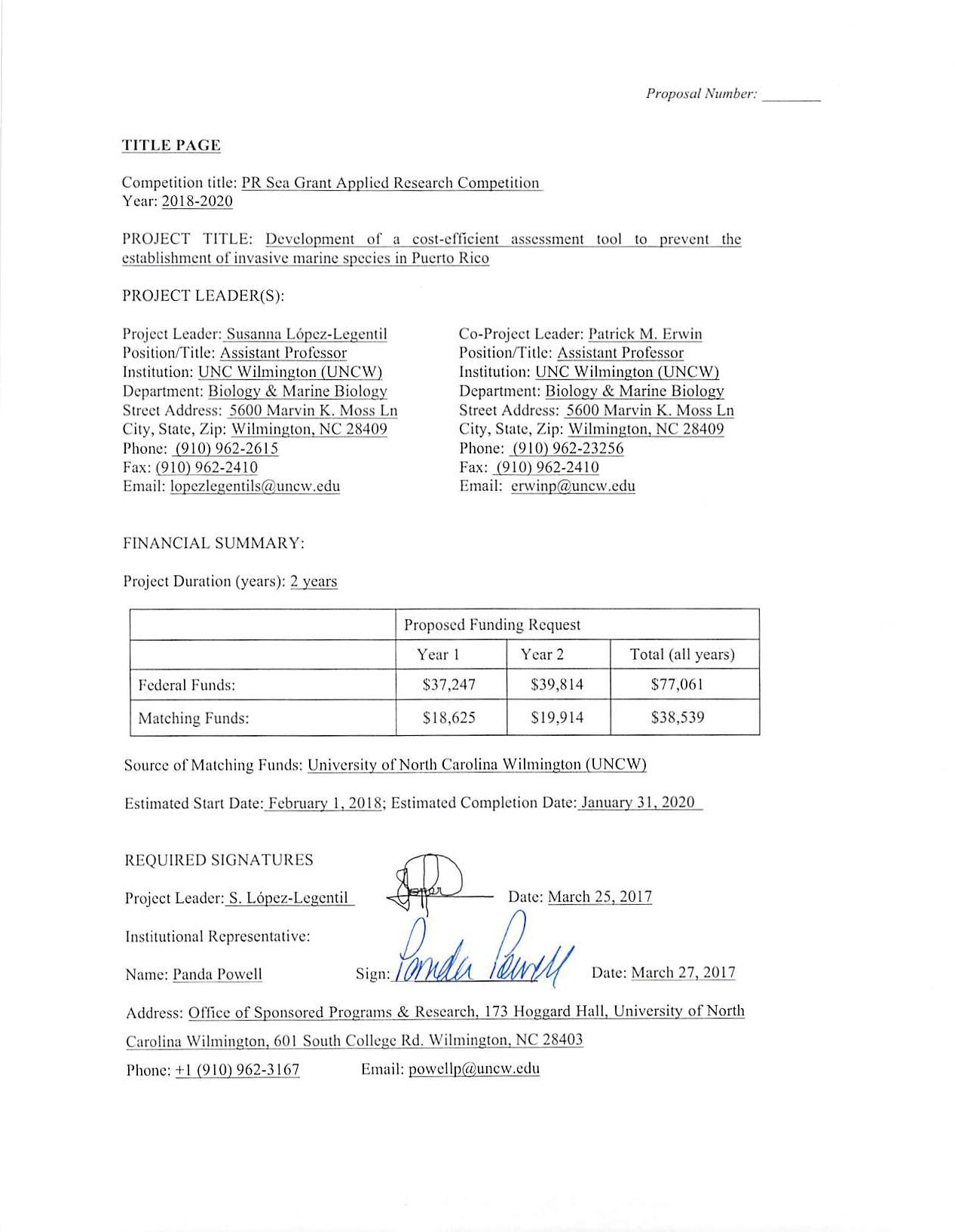
PROJECT SUMMARY FORM (90-2)
INSTITUTION (Program): PR
TITLE: Development of a cost-efficient assessment tool to prevent the establishment of invasive marine species in Puerto Rico
PI: Susanna López-Legentil
AFFILIATION: University of North Carolina Wilmington
2ND PI: Patrick M. Erwin
AFFILIATION: University of North Carolina Wilmington
TOTAL FEDERAL $ REQUEST: $77,061
TOTAL MATCH $: $38,539
FOCUS AREAS: Healthy Ecosystems and Habitats
PARTNERS: Authorities from 16 Puerto Rican harbors and marinas, G. Lambert (Ascidian Taxonomist Consultant), E. Weil (University of Puerto Rico), G. Ramirez (Center for Environmental Education, Conservation and Research in Puerto Rico), and X. Turon (WRIMS and AWD database editor)
OBJECTIVES: To provide local communities and interested agencies with an interactive catalog of ascidian species in Puerto Rican harbors and marinas and of a ‘Watch List’ to rapidly identify and monitor species of special concern. We will establish areas of the coastline most vulnerable to species introductions and develop an easy, web-based ‘Assessment Tool’ to help detect the arrival of new species and monitor the spread of potentially detrimental species. We will also design training sessions with harbor authorities and resource managers, including best practices discussions, and a seminar series for the general public in English and Spanish. We aim to increase stakeholder awareness and stewardship while providing resource managers with a practical tool kit to help them eradicate or at least palliate economic losses and natural ecosystem damage from invasive species.
METHODOLOGY: Sixteen harbors and marinas along the Puerto Rican coast will be surveyed and sampled during the first year of the grant. All harbor managers have been contacted and have expressed their interest for this project. Samples will be identified based on morphological characters and molecular barcoding, then classified as ‘native’, ‘cryptogenic’, ‘introduced’, or ‘invasive’. Multivariate statistical analyses will be used to uncover patterns and pathways of secondary spread among harbors by comparing ascidian diversity and distribution across marinas. Taxonomic identifications and invasive status determinations will culminate in (1) a user-friendly catalog of ascidian species in Puerto Rican harbors, (2) a one-page ‘Watch List’ of species of concern, and (3) a web-based, interactive ‘Assessment Tool’ The second year of the grant will focus on distributing these resources to and engaging with harbor managers, the Puerto Rican scientific community and local environmental groups.
RATIONALE: Globalization is altering the distribution of the world’s biodiversity and creating opportunities for species to colonize new areas. Accordingly, biological invasions cause significant economic ($137 billion annually in the US) and ecological damage, representing the second greatest threat to biodiversity. Critical to mitigating these impacts are cost-efficient assessment tools to rapidly detect the arrival of new species, monitor the spread of established ones, and design effective containment and eradication plans. This request focuses on ascidians, sessile invertebrates that act as bioindicators of species introductions at large and models of invasive species spread and ecosystem impacts The appearance of new species typically occurs first on artificial substrates of harbors and marinas, prior to secondary spread into native ecosystems, thus allowing a window of opportunity to identify and protect high-risk areas With the last ascidian inventory in Puerto Rico occurring over 80 years ago, a current catalog and interactive assessment tool are required to identify and monitor areas most vulnerable to species introductions. Long-term success hinges on stakeholder involvement at all levels: the information and products of this proposal will be distributed widely to these communities through on-site training and general public outreach events designed to engage and empower local communities.
BUDGET SUMMARY (90-4) – YEAR 1
PROJECT TITLE: Development of a cost-efficient assessment tool to prevent the establishment of invasive marine species in Puerto Rico
PRINCIPAL INVESTIGATOR: Susanna López-Legentil, Assistant Professor UNCW; Patrick Erwin, Assistant Professor UNCW
SALARIES AND WAGES:
1. Senior Personnel
a. (Co) Principal Investigator: 2
b. Associates (Faculty or Staff): Sub Total:
2. Other Personnel
a. Professionals:
b. Research Associates:
c. Res. Asst./Grad. Students: 1
d. Prof. School Students:
e. Pre-Bachelor Student(s):
f. Secretarial-Clerical:
g. Technicians:
h. Other:
B. FRINGE BENEFITS:
Control No. 0648-0362 Expiration Date 1/31/2018
NO.:
OMB Control No. 0648-0362
BUDGET SUMMARY (90-4) – YEAR 2
PROJECT TITLE: Development of a cost-efficient assessment tool to prevent the establishment of invasive marine species in Puerto Rico
PRINCIPAL INVESTIGATOR: Susanna López-Legentil, Assistant Professor UNCW; Patrick Erwin, Assistant Professor UNCW
SALARIES AND WAGES:
1. Senior Personnel
a. (Co) Principal Investigator: 2
b. Associates (Faculty or Staff): Sub Total:
2. Other Personnel
a. Professionals:
b. Research Associates:
c. Res. Asst./Grad. Students: 1
d. Prof. School Students:
e. Pre-Bachelor Student(s):
f. Secretarial-Clerical:
g. Technicians:
h. Other:
B.
Expiration Date 1/31/2018
NO.:
BUDGET SUMMARY (90-4) – TOTAL
PROJECT TITLE: Development of a cost-efficient assessment tool to prevent the establishment of invasive marine species in Puerto Rico
PRINCIPAL INVESTIGATOR: Susanna López-Legentil, Assistant Professor UNCW; Patrick Erwin, Assistant Professor UNCW
SALARIES AND WAGES:
1. Senior Personnel
a. (Co) Principal Investigator: 2
b. Associates (Faculty or Staff): Sub Total:
2. Other Personnel
a. Professionals:
b. Research Associates:
c. Res. Asst./Grad. Students: 1
d. Prof. School Students:
e. Pre-Bachelor Student(s):
f. Secretarial-Clerical:
g. Technicians:
h. Other:
Control No. 0648-0362 Expiration Date 1/31/2018
NO.:
López-Legentil & Erwin
BUDGET JUSTIFICATION
Budget Summary:
Total Requested PR Sea Grant: $77,061 for two years ($37,247 year 1 + 39,814 year 2).
Federal Funds Year 1
SLL: Susanna López-Legentil
PME: Patrick M. Erwin
A. Salaries and Wages
Senior Personnel
SLL and PME are requesting 0.8 month summer salary ($5,500 each).
Other Personnel
3 months of summer salary for a graduate student at UNCW: $1,278x3 = $3,834
B. Fringe Benefits
Senior Personnel
Fringe benefits faculty = 22% of salary. $11,000x0.22 = $2,420.
Other Personnel
Fringe benefits students (summer) = 9.15% of salary. $3,834x0.0915 = $351.
C. Permanent Equipment
None is requested.
D. Expendable Supplies and Equipment
The following items are required for sampling and sample preservation:
Other necessary materials (e.g., tweezers, scissors, magnifying glass, calipers) are available in our Lab at no additional cost to this grant.
E. Travel
4 participants: SLL, PME, Gretchen Lambert (Ascidian Taxonomy Consultant), Graduate Student. SLL and PME flights will be purchased with cost matching funds (see below).
1 flights from Wilmington (NC) to San Juan PR (Graduate Student) = $500. Flight from Seattle (WA) to San Juan PR (Gretchen Lambert) = $780.
Expected length of field trip = 10 days. In-state per diem, including hotel = $105.2 per person and day. 105.2x10x4 = $4,208. Car rental = $612 (Medium size).
F. Publications and Documentation Costs
None.
G. Other Costs
Consultant fee $695 (Gretchen Lambert; Ascidian Taxonomy Consultant)
H. Indirect Costs
F&A is charged at 49% modified total direct costs.
Matching Funds Year 1
In-kind matching funds will be provided by UNCW (see cost-sharing commitment letter) as follows:
A. Salaries and Wages
Senior Personnel
None.
Other Personnel
Graduate student salary at UNCW during the academic year = $11,500.
B. Fringe Benefits
None applicable.
C. Permanent Equipment
None requested.
D. Expendable Supplies and Equipment
None.
E. Travel
2 flights from Wilmington (NC) to San Juan PR (SLL, PME) = $500x2 = $1,000.
F. Publications and Documentation Costs
None.
G. Other Costs
None.
H. Indirect Costs
F&A is charged at 49% modified total direct costs.
Federal Funds Year 2
SLL: Susanna López-Legentil
PME: Patrick M. Erwin
A. Salaries and Wages
Senior Personnel
SLL and PME are requesting 0.8 month summer salary ($5,500 each).
Other Personnel
3 months of summer salary for a graduate student at UNCW: $1,278x3 = $3,834.
B. Fringe Benefits
Senior Personnel
Fringe benefits faculty = 22% of salary. $11,000x0.22 = $2,420.
Other Personnel
Fringe benefits students (summer) = 9.15% of salary. $3,834x0.0915 = $351.
C. Permanent Equipment
None is requested.
D. Expendable Supplies and Equipment
The following items are required for ascidian barcoding: DNA extraction (DNA Blood & Tissue Kit), PCR amplification (Primers, MyTaq super mix), gel electrophoresis (GelRed, TBE, Agarose), cleaning of PCR product (QIAquick PCR Purification Kit), and DNA sequencing (BigDye Terminator, BigDye Xterminator Kit) of 250 samples. A few materials (i.e., gloves, microcentrifuge tubes) necessary to accomplish the above-mentioned tasks are also requested.
Other necessary materials (e.g., automatic pipets, pipet tips, racks, freezer boxes) are available in our Lab at no additional cost to this grant.
E. Travel
3 Participants: SLL, PME, Graduate student. Flights from Wilmington (NC) to San Juan (PR) = $500x3 = $1,500.
Expected length of field trip = 1 week (7 days). In-state per diem, including hotel = $105.20 per day. 105.2x7x3 = $2,209.2. Car rental = $410.8 (Medium size).
F. Publications and Documentation Costs
$1,500 are requested to publish results in an open access journal.
G. Other Costs
DNA sequencing of 250 samples at UNCW Center for Marine Science ($1 per sequence). Each sample is sequenced twice using either the forward or reverse PCR primer: 250x2x$1 = $500.
H. Indirect Costs
F&A is charged at 49% modified total direct costs.
Matching Funds Year 2
In-kind matching funds will be provided by UNCW (see cost-sharing commitment letter) as follows:
A. Salaries and Wages
Senior Personnel
None.
Other Personnel
Graduate student salary at UNCW during the academic year = $11,500.
B. Fringe Benefits
None applicable.
C. Permanent Equipment
None requested.
D. Expendable Supplies and Equipment
None.
E. Travel
SLL and PME will receive each $500 to present results obtained here at the annual Benthic Ecology Meeting.
F. Publications and Documentation Costs
35 copies of resulting species catalog and ‘Watch List’ in laminated paper (35 x $9 = $315) to distribute to all participant harbors, interested government agencies, dive clubs, and non -profit organizations and 16 copies in poster format (16 x $34.37 = $550) for all participant harbors. Total documentation costs $865.
G. Other Costs
SLL and PME own the domain www.imesalab.com. Design and maintenance of this web are performed routinely by SLL and comes at no additional cost.
H. Indirect Costs
F&A is charged at 49% modified total direct costs.
PROPOSAL NARRATIVE
Title: Development of a cost-efficient assessment tool to prevent the establishment of invasive marine species in Puerto Rico
PI: Susanna López-Legentil; Department of Biology and Marine Biology, University of North Carolina Wilmington (UNCW)
Co-PI: Patrick Erwin; Department of Biology and Marine Biology, University of North Carolina Wilmington (UNCW)
PROJECT RATIONALE
Biological
Invasions are Increasing Worldwide




Globalization is altering the distribution of the world’s biodiversity and creating opportunities for species to colonize new areas. Accordingly, non-indigenous species (NIS) have become increasingly prevalent around the world, largely due to human-mediated introductions in marine ecosystems (Ruiz et al. 1997). Indeed, the increased number of artificial substrates and worldwide shipping has caused an accelerated spread of marine NIS worldwide (Glasby and Connell 1999; Seebens et al. 2013; Lin et al. 2015) and changes in temperature regimes typically favor NIS to the detriment of native species (Stachowicz et al. 2002; Zerebecki and Sorte 2011). Thus, current trends in human development activities and climate patterns indicate that the appearance of new marine NIS will be an ongoing issue for many years to come.
In addition to new marine NIS introductions, the spread of already established NIS needs to be carefully considered. Once a species is well established in a new area, local fishing and recreational boating potentially facilitate further range expansion to other harbors but also to nearby natural ecosystems (Wasson et al. 2001; Darbyson et al. 2009; Davidson et al. 2010; López-Legentil et al. 2015b). Thus, harbors and marinas play crucial roles in the introduction of marine species, including the initial inoculation of a species from another area and the subsequent, secondary spread at a local level (also called pre-border and post-border processes; Forrest et al. 2009).
Biological Invasions cause Environmental Impacts with High Economic Costs
Once a NIS escapes its entry port and becomes established in the surrounding natural environment, the species is considered invasive (Blackburn et al. 2011). Marine invasive species represent a severe threat to the functioning and economic value of native ecosystems by displacing native species, disrupting local communities and harming aquaculture activities (Lovell and Stone 2005; Molnar et al. 2008). The direct costs of invasive species include losses and damages to ecosystem services and the costs of implementing control measures. Once NIS become invasive, attempts to manage further spread and damage become increasing expensive and less effective, often even futile (Thresher and Kuris 2004; Coutts and Forrest 2007).
Accordingly, biological invasions are the second greatest threat to biodiversity (after habitat destruction), with economic damage in the US estimated at $137 billion annually (Pimentel et al. 2000, 2005). A critical aspect of managing the economic impacts of invasive species is the development of costefficient assessment tools for the early detection of NIS, prior to the escalation of control costs that occurs once a species becomes invasive. Such tools provide a feasible means to manage species introductions through the design goals of: (1) rapidly detecting the arrival of new NIS, (2) monitoring the secondary spread of established NIS, and (3) understanding the introduction pathways utilized by invasive species.
Ascidians are Sentinels of Biological Invasions
Developing a cost-efficient assessment tool to prevent the introduction and spread of invasive species
requires identifying a model group of organisms that is representative of broader introduction pathways and processes. This request focuses on ascidians or sea-squirts (Chordata; Tunicata; class Ascidiacea), sessile invertebrates that act as bioindicators of invasive species introductions, NIS spread and their cascading effects on ecosystem functioning and resilience (Zhan et al. 2015). Ascidians are among the first taxa that colonize human-altered marine habitats and many species have been introduced worldwide (La mbert 2007; Shenkar and Swalla 2011; Zhan et al. 2015). In 2011, Shenkar and Swalla reported 64 global introduced ascidian species, 50 of which were observed in temperate environments. More recently, Zhan et al. (2015) increased that number to 80 species based on an exhaustive review of the literature. Thus, ascidians are among the most notorious invaders of marine ecosystems and have been proposed as ideal models for studying invasion success and evaluating the effectiveness and efficiency of applied policies and management solutions. Importantly, ascidian models share introduction vectors and pathways with other, non-ascidian NIS, and thus can be used as sentinels for biological invasions while providing insight into how to prevent the colonization and spread of a wide range of notorious marine NIS (Zhan et al. 2015). In addition, ascidians are ideally suited for the study of introduction processes, specifically as related to harbor dynamics, due to four critical features of their biology and ecology:
1. Asci dians are easy to collect and monitor.
- As sessile invertebrates, adult ascidians are permanently attached to substrate.
- This feature facilitates collection, identification and monitoring efforts.
2. Ascidians are abundant on artificial substrates of harbor h abitats.
- Ascidians thrive in the eutrophic, polluted waters of harbor habitats (Lambert 2007).
- This feature facilitates cross - habitat comparisons, as ascidians are ubiquitous members.
3. Ascidians rely on human-mediated transport for their long-distance dispersal.
- Ascidian larvae are short-lived, non-feeding and usually settle within a few hours or 1-2 days (Svane and Young 1989; Lambert 2005; Rius et al. 2010a,b).
- This feature facilitates the identification of natural vs. human-mediated dispersal pathways.
4. Ascidian introductions are on-going (“recurrent”) processes
- Recurrent introductions are common in ascidians, which increase propagule pressure and the probability of a successful introduction (Dupont et al. 2010; Goldstein et al. 2011; Pineda et al. 2011; Rius et al. 2012).
- This feature facilitates temporal monitoring efforts, as ascidian introductions are constant rather than punctuated, historical events.
Keys to the Success of Introduced Ascidians
Successfully introduced ascidians have a series of biological characteristics that enable them to quickly become established in a new habitat, including the ability to outcompete resident species (Rius et al. 2009b; Aldred and Clare 2014) and long breeding seasons, high reproductive capacities (including self-fertilization in some species), and population growth rates (Rocha 1991; Lambert 2005; Dupont et al. 2007; Pineda et al. 2013). The long-term establishment and reproductive success of an introduced ascidian also depends on both the physical (notably water temperature and salinity) and biological (resident biota) conditions characterizing the new habitat (Brunetti et al. 1980; Vázquez and Young 2000; Whitlatch and Osman 2009; Pineda et al. 2012a,b). To date there are still relatively few instances of introduced ascidians becoming invasive and spreading to natural habitats (Castilla et al. 2004; Rius et al. 2009b; Lambert 2009; Morris and Carman 2012; Stefaniak et al. 2009, 2012). However, many species of ascidians have established themselves on artificial substrates as fouling organisms (Figure 1), increasing management costs and impairing the normal development of commercial species in aquaculture facilities (reviewed in Aldred and Clare 2014). Moreover, a recent study found that altered seawater temperatures due to climate change will also favor the spread and abundance of introduced ascidians across multiple spatial scales (Rius et al. 2014).

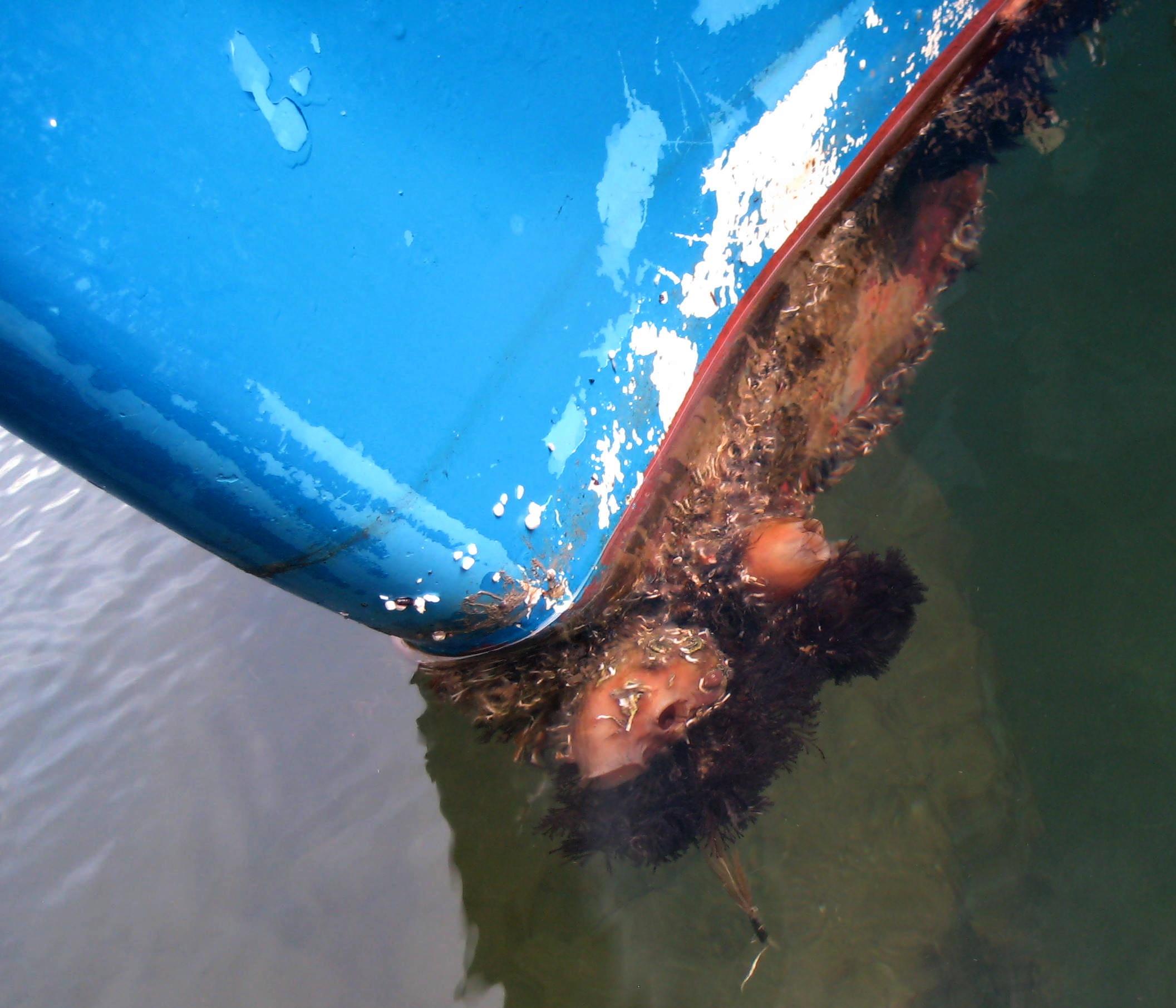
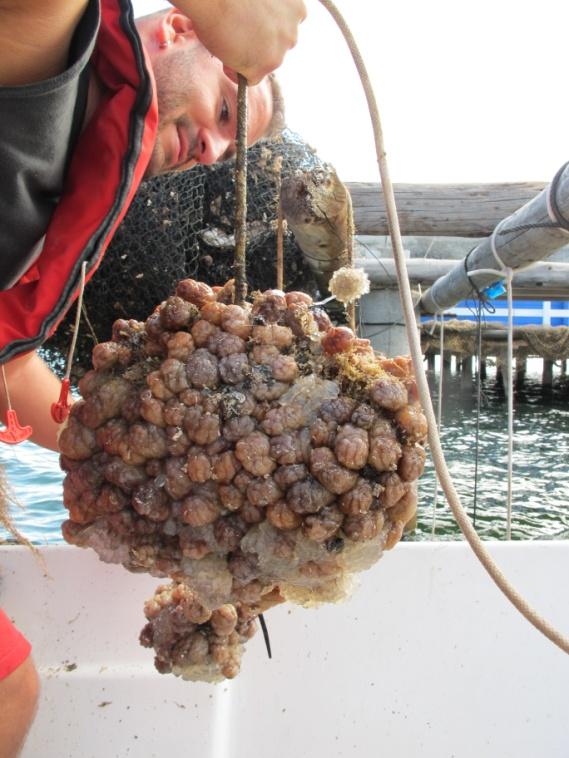
Applying Ascidian Models to Protect Puerto Rican Natural Resources
The first appearance of introduced ascidian species in a location usually occurs on the artificial substrates in harbors and marinas, prior to secondary spread among artificial habitats and into native ecosystems. The time period between the initial introduction and secondary spread provides a critical window of opportunity to identify and protect high-risk areas. Utilizing this window of opportunity to identify new NIS requires: (1) a comprehensive catalog of species currently inhabiting harbors, and (2) periodic surveys to monitor and detect introduction events. An up-to-date catalog is paramount for rapid detection of NIS and coordination of eradication responses to prevent future spread of detrimental species to the surrounding environment. Such species inventories not only incorporate taxonomic surveys with complementary genetic data (‘barcoding’ is mandatory in the face of taxonomic conundrums; Zhan et al. 2015), but also provide a thorough assessment of inter-harbor NIS distribution patterns, allowing for the definition and delineation of efficient internal borders for further action. While the critical importance of up-to-date species catalogs and periodic surveys for preventing the spread of detrimental NIS is well documented in the literature, few government agencies possess such information and stakeholders are rarely informed of or provided with practical tools for identifying and taking action against NIS spread.
In Puerto Rico, a considerable knowledge gap exists concerning the ecological and economic impact of marine NIS, despite the well-documented negative impacts in related Caribbean ecosystems and the known economic value of coastal and marine habitats for the Puerto Rican economy. For example, the total economic value (use and passive value) of coral reefs in Puerto Rico is estimated at over $1 billion annually (Brander and van Beukering 2013). NIS represent a direct threat to this economic value (see Bak et al. 1996). Among the best known marine NIS in Puerto Rico are two species of quahog clams Mercenaria campechiensis and M. mercenaria (Appeldoorn 1997; Chew 2001), the Mozambique tilapia Oreochromis mossambicus (Neal et al. 2009), and the euryhaline leech Myzobdella lugubris, often reported to infect the tilapia and blue and siri crabs (Bunkley-Williams and Williams 1994). Two additional marine NIS of particular concern are the introduced jellyfish Drymonema dalmatinum and the red lionfish Pterois volitans, both observed in Puerto Rico and known to cause great economic and ecological damage once established (Larson 1987; Schofield 2009). Ascidian introductions have become a global problem (Lambert 2007) and a prominent area of marine invasion biology, yet few countries and US states possess a catalog of ascidian species in their waters (fewer still in high-risk harbors and marina habitats), and Puerto Rico is no exception. In fact, the last ascidian inventory in Puerto Rico occurred over 80 years ago (Van Name 1930) and a current NIS catalog is urgently required to identify the most vulnerable areas to species introductions, ecosystem disruption and economic damage.
PROJECT OBJECTIVES
This project will provide harbor managers, public agencies and local stakeholders with a user-friendly catalog of ascidian species in Puerto Rican harbors and an invasive species ‘Watch List’ (Expected Outcome 1) to identify and monitor species introductions and mitigate their ecological and economic impacts. In addition, we will establish areas of the coastline most vulnerable to species introductions and develop an easy, web-based assessment tool (Expected Outcome 2) to detect the arrival of potential detrimental species and offer guidance on how to best manage their spread. We will conduct training sessions with harbor authorities and resource managers (Expected Outcome 3) and a seminar series with the general public (in English and Spanish, Expected Outcome 4) to engage stakeholders and translate our research findings into actionable strategies and best practices. Through these research and outreach activities, we aim to increase stakeholder awareness and stewardship while providing resource managers with a practical tool kit to ultimately prevent natural ecosystem damage and economic losses from invasive species.
MATERIALS AND METHODS
Collection Sites: Sixteen harbors representing recreational and fishing marinas along the Puerto Rican coast will be sampled during the first year of the grant (Figure 2). The targeted harbors are 6 small-sized (<100 wet slips), 6 medium-sized (100–199 wet slips) and 4 large-sized (200+ wet slips) marinas, including the largest marina in the Caribbean (Puerto del Rey Marina, 1,000 wet slips). In addition to their size range, these harbors are distributed along the >500 km coastline and were selected to represent all major coastal regions of Puerto Rico, encompassing northern (n = 4), southern (Porta Caribe, n = 5), eastern (n = 4) and western (Porta del Sol, n = 3) coastal areas.
Data Collection: Sampling of each harbor will be conducted using a variant of the Rapid Assessment Method (Campbell et al. 2007), as described in López-Legentil et al. (2015b). Briefly, we will record all ascidian species observed on submerged artificial substrata in each harbor to maximize coverage and collate exhaustive species lists. Following each harbor survey, categorical relative abundance data (rare, common, abundant) will be estimated for each ascidian species according to the number of individuals (or colonies) observed relative to the harbor size. Representative samples and unknown ascidian taxa will be collected, preserved and processed for morphological and molecular identifications, as described below.
Morphological Identification: Samples will be fixed in 4% formaldehyde buffered with filter seawater and sodium borate. Identification of specimens based on morphological characters (see below Expected Outcomes 1, 2) will be conducted under the supervision of Gretchen Lambert, a
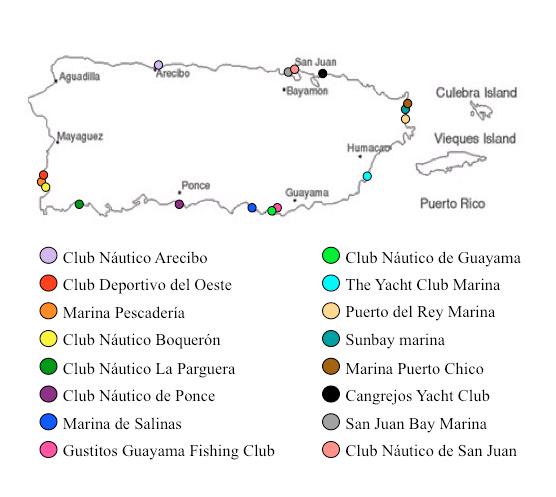
Fig. 2. Targeted harbors along the Puerto Rican coast, representing a broad range of harbor sizes (50 to 1,000 wet slips) from all coastal regions of the island.
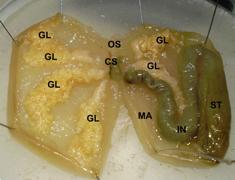
Fig. 3. Dissection of the introduced ascidian Styela plicata, after removing the branchial sac GL: Gonadal lobe; OS: Oral siphon; CS: Cloacal siphon; IN: Intestine; ST: Stomach; MA: Mantle.
worldwide expert in ascidian taxonomy and co-editor of the Ascidiacea World Database (see Letter of Support and CV). Photographs in situ and during dissection (Figure 3) and key morphological characters to identify each species will also be summarized in the ‘Ascidian Assessment Tool’ (see below Expected Outcomes 1, 2). Relevant literature to perform this task includes Van Name (1930), Millar (1962, 1974), Millar and Goodbody (1974), Monniot (1983a,b,c,d), Monniot and Monniot (1984, 1985), Goodbody (1984, 1993, 1995, 2000, 2003, 2004), Rocha et al. (2005), Goodbody and Cole (2006), Bonnet and Rocha (2011), Hirose et al. (2012).
Molecular Identification (“barcoding”): Branchial tissue of solitary specimens or colony fragments (tunic and zooids) for colonial species will be preserved in 100% ethanol and stored at -20°C until processed. For colonial species, zooids will be carefully separated from the tunic under a stereomicroscope. DNA will be extracted from branchial tissue or separated zooids using the DNeasy Blood & Tissue kit (Qiagen, Hilden, Germany). Three primer sets are available to amplify the barcoding fragment of the Cytochrome c Oxidase subunit I (COI) mitochondrial gene in ascidians: (1) the universal primers LCO1490 and HCO2198 (Folmer et al. 1994), (2) the Tun_forward and Tun_reverse2 primers described by Stefaniak et al. (2009), and (3) the recently designed pair XTfwd 5’ TCI-ACW-AAY-CAT-AAA-GAT-ATT-RG 3’ and XTrev 5’ TAM -ACY-TCW-GGR-TGI-CYR-AAR-AAY-CA 3’ (unpublished). PCR reactions and amplification cycles are optimized for each sample and primer set, but in general consist of 0.5µL of each primer (10µM), 11µL of PCR water, 12.5µL of MyTaq HS MIX (2X; Bioline, Tauton MA, USA), and 0.5µL of DNA for a total volume of 25µL. PCR amplification cycles are as follows: 95°C for 1min, 35 amplification cycles (95°C for 15sec, 42 to 45°C for 15sec, and 72°C for 10sec), and a final extension step at 72°C for 1min. Amplicons will be sequenced in a new Applied Biosystems 3500 genetic analyzer available at the UNCW Center for Marine Science. The resulting DNA sequences will be aligned using the software Geneious (v. R8. Biomatters, Auckland, New Zealand) and compared with ascidian reference sequences available in GenBank® via BLASTn searches. Our research team has barcoded hundreds of ascidian species from around the world using these methods (e.g., Turon and López-Legentil 2004; López-Legentil and Turon 2005; López-Legentil et al. 2013, 2015c; Turon et al. 2016). Sequence barcodes will be deposited on the publicly available database GenBank® and given a unique identifier number (called an Accession Number). A direct link to each GenBank entry will also be made available for each species via the ‘Ascidian Assessment Tool’ (see below Expected Outcomes 2).
Data Analyses: Each identified species will be classified according to its origin: ‘native’, ‘cryptogenic’, ‘introduced’, or ‘invasive’ following Carlton (1996) and Blackburn et al. (2011). The terms ‘introduced’ and ‘cryptogenic’ both refer to species well established in an area of reduced dimension (often a harbor or marina). The difference between ‘introduced’ and ‘cryptogenic’ lies in the origin of the species: while the native area of an introduced species is known, the native distribution of a cryptogenic species is unknown (Carlton 1996). The status of each ascidian species will be determined based on (1) Shenkar and Swalla (2011), who reported 64 global introduced species, (2) Zhan et al. (2015), who recently described 80 known introduced species based on an exhaustive literature review, and (3) the Ascidiacea World Database, which assigns a potential native origin for each ascidian species and provides an exhaustive list of locations where
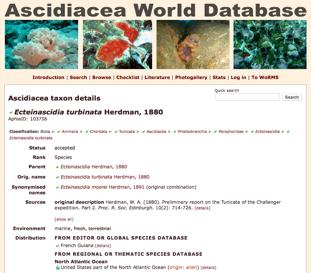
Fig. 4 Source information for the ascidian Ecteinascidia turbinata according to the Ascidiacea World Database. Note that the web provides a putative geographic origin for the species as well as lists sites where it is considered ‘Alien’ (=Introduced, NIS).
the species has been observed and deemed ‘Alien’ (Figure 4). These data will be used to construct a onepage ‘Watch List’ of species of special concern (e.g., globally distributed taxa), based on Locke (2009) and updated information available through the World Register of Introduced Marine Species (WRIMS). The ‘Watch List’ will include pictures, descriptions and diagnostic features of notorious ascidians species to allow non-experts to identify potential introductions and monitor secondary spread along the Puerto Rican coast.
To uncover patterns and pathways of secondary spread among harbors, multivariate statistical analyses will be used to compare ascidian diversity and distribution across marinas. Two similarity matrices will be created: the first will be based on presence-absence and the second will be based on the relative abundance of each species found at each marina. Matrices will be constructed using the BrayCurtis index and results will be visualized with non-metric multidimensional scaling (nMDS) plots.
Permutational analyses of variance (PERMANOVA) will be conducted to assess the effects of latitudinal position of the investigated harbors and marinas on ascidian diversity and distribution. Analyses will be done using the Primer v6.1.10 statistical package (Clarke and Gorley 2006) with the PERMANOVA+ β20 module (Anderson et al. 2008) incorporated. Additionally, mantel tests will be conducted to test for correlations between geographic distances among marinas and ascidian community dissimilarity for both the presence-absence and relative abundance data. GPS coordinates of the 16 sites will be used to calculate the shortest surface distances between pairs of harbors using free software developed by Byers (1997). Mantel tests will be performed using the ade4 package for R with significance testing by permutation (Dray and Dufour 2007)
Webpage Design and Maintenance: The proposal PIs S. López-Legentil (SLL) and P. Erwin own and personally manage the domain that hosts their research laboratory (iMESA Lab) website: www.imesalab.com. The ‘Ascidian Assessment Tool’ (see below Expected Outcome 2) will be hosted on the iMESA Lab main website and curated by SLL using iWeb software. The ‘Ascidian Assessment Tool’ is guaranteed to remain active for at least 15 years, as the PIs own the domain and are able to independently design and manage the website.
EXPECTED OUTCOMES
1. Catalog of Ascidians in Puerto Rican Harbors (Years 1-2): Data from field surveys, taxonomic identifications and invasive status determinations will culminate in a user-friendly catalog of ascidian species in Puerto Rican harbors. The catalog will include: scientific and common names of ascidians, their invasive status, morphological descriptions, diagnostic features and in situ photographs of the animals. The catalog will represent a final product and static resource for future taxonomic work and on-going invasive species monitoring efforts. The primary target audience for this product will be harbor managers, the Puerto Rican scientific community and local environmental groups, with distribution to these stakeholder groups in print and electronic formats during site visits (Year 2). In addition, copies will be sent to federal agencies in Puerto Rico (e.g., U.S. Fish and Wildlife Service, Environmental Protection Agency) and local non-profit organizations concerned about environmental best practices (e.g., “Sociedad Ambiente Marino Puerto Rico” and the Center for Environmental Education, Conservation and Research). A special feature of the catalog, the ascidian ‘Watch List’, will highlight in a one-page format the species of special concern, with directions to the ‘Ascidian Assessment Tool’ (see below ). This feature is designed to be a succinct, widely distributed tool for invasive species monitoring by the stakeholder groups targeted above, as well as, local dive operations to extend monitoring efforts to natural habitats.
2. Ascidian Assessment Tool (Years 1-2): Complementing the static catalog resource (see above), this product represents a dynamic resource designed to disseminate up-to-date information and interact with local community monitoring efforts on an on-going basis The tool will be an interactive webpage, in both English and Spanish, dedicated exclusively to Puerto Rican ascidian species with (1)
detailed photographs of animal dissections (Figure 3) and descriptions of morphological observations to provide a more in-depth resource for ascidian identification using classical approaches, and (2) a barcoding tool kit with step-by-step instructions on how to submit requests for sample identification (taxonomic and molecular) of previously unreported animals or ‘Watch List’ species of concern. The objective of this tool is to provide a platform for engaging and interacting with local stakeholders, through periodic updates and a direct link to PI contact information, while simultaneously connecting with the scientific community and consolidating information in the field of ascidian taxonomy.
3. On-Site Training Sessions (Year 2): The second year of the proposal will focus on distributing the results of Year 1 data to local stakeholders and offering training sessions to stimulate marine NIS monitoring efforts in Puerto Rico. Specifically, we will meet with harbor authorities and resource managers to familiarize stakeholders with the ‘Catalog of Ascidians’ (copies will be provided) and ‘Watch List’ (Expected Outcome 1) and the ‘Ascidian Assessment Tool’ webpage (Expected Outcome 2). We will employ a combination of seminar presentations, hands-on training and best practices discussion sessions to help stakeholders manage marine NIS through periodic surveys of their docks. The managers of harbors targeted by this proposal have already expressed their interest in hosting our team for training sessions and discussions of best management practices (see Letters of Support) and the PIs will offer sessions in English (native language of co-PI Erwin) and Spanish (native language of PI López-Legentil).
4. General Public Outreach (Year 2): In addition to site visits at Puerto Rican harbors, we will stage seminars and discussion sessions targeting the broader public through institutional platforms at Puerto Rican universities and non-profit organizations. Again, the PIs will offer seminars in English or Spanish, pending the preference of the host organization. Several Puerto Rican institutions have already expressed interest in such talks, with confirmed invitations from the University of Puerto Rico (E. Weil) and the Center for Environmental Education, Conservation and Research at the Inter American University of Puerto Rico (G. Ramirez; see Letters of Support). These events will include additional dissemination of copies of the ‘Catalog of Ascidians’ and ‘Watch List’ (Expected Outcome 1) to interested attendees. Additional outreach efforts routinely conducted by our Lab through social media platforms (Twitter @iMESALab, Instagram imesalab) will be expanded to incorporate progress updates, pictures and results derived from the work described in this proposal and to help increase web traffic to our online resources.
5. Scientific Community Engagement (Year 2): Results from this project will be made available to the scientific community through publication in peer-reviewed journals (e.g., Biological Invasions, Aquatic Invasions) and presentations at relevant national and international conferences (e.g., Benthic Ecology Meetings, International Invasive Sea Squirt Conference). Both PIs have a strong publication record (e.g., >25 publications each in the last 5 years alone) and expect to continue these levels of productivity. In addition, introduced ascidian species identified herein will be integrated with two international, scientific databases to further facilitate access to our results: (1) the World Registry of Introduced Marine Species database (WRIMS), and (2) and The Ascidiacea World Database (AWD; directly linked to the World Register of Marine Species -WoRMS).
STAKEHOLDER PARTICIPATION
We have already reached out to stakeholders in the preparation of this proposal to gauge interest in our research objectives. We are excited to report that our proposal has raised a lot of interest from a diverse group of stakeholders in Puerto Rico, including harbor managers and Board of Trustees members, university professors, and environmental centers. This level of stakeholder engagement is very promising and our contact and interactions with stakeholder groups will only grow as we implement the objectives of this research program (see Expected Outcomes). Confirmed stakeholder participation to date includes:
• All harbors targeted herein (Figure 2) have expressed their interest in this research. So far, we have received 5 Letters of Support from harbor authorities and the remaining ones are pending
official approval at upcoming Board of Trustees meetings.
• All harbors have also expressed their interest in hosting an on-site training session (Expected Outcome 3) to learn to identify ascidian species and discuss how to best manage these species in summer 2019 (see Letters of Support).
• Several public institutions (see Letters of Support) have offered to host a seminar and discussion session by our team during summer 2019 (Expected Outcome 4), including the University of Puerto Rico (host: Professor Ernesto Weil), and the Center for Environmental Education, Conservation and Research at the Inter American University of Puerto Rico (host: Dr. Graciela Ramirez).
• A contributing curator to two widely utilized databases (Dr. Xavier Turon) has agreed to make the data obtained herein available to the general public and scientific community (Expected Outcome 5) through The World Register of Introduced Marine Species (WRIMS) and The Ascidiacea World Database (AWD; see Letter of Support)
ALIGNMENT WITH PUERTO RICO SEA GRANT PRIORITIES
The main objective of this proposal fits within PR Sea Grant strategic plan ‘Healthy Ecosystems and Habitats,’ aiming to increase stakeholder awareness and stewardship (i.e , harbor administrators, boat users and local residents) while providing resource managers with a practical tool kit to identify ascidian NIS and monitor the spread of potentially detrimental species In addition, the proposal satisfies several of the National Sea Grant College Program’s focus areas:
• “Inventory and population studies of important coastal species and biological resources” We will produce a catalog of all ascidian species in Puerto Rican harbors and marinas, a foundational resource for the identification of introduced species and first step in invasive species management. Further, ascidians are an important component of benthic communities and littoral food webs (Gili and Coma 1998; Teixidó et al. 2002) and harbor a high diversity of microbial symbionts within their bodies (Erwin et al. 2013, 2014; Tianero et al. 2015; López-Legentil et al. 2015a,c, 2016). These cryptic communities represent an important biological resource, contributing to key biogeochemical cycles (Erwin et al. 2014) and the production of bioactive secondary metabolites (Tianero et al. 2015). Thus, ascidians act as a repository of microbial species yet to be characterized and play a key role in the proper functioning of ecosystems.
• “Impacts of climate change” Climate change is expected to favor and further facilitate the spread of marine introduced and invasive species (Stachowicz et al. 2002; Zerebecki and Sorte 2011), including ascidians (Rius et al. 2014). However, no baseline information currently exists for introduced ascidians in Puerto Rico, making detection of new arrivals difficult and assessments of increased introductions impossible. The current proposal will fill this important knowledge gap and establish a baseline of current ascidian species in Puerto Rico harbors and marinas, thus facilitating the early detection of new and potentially detrimental species to the island.
• “Establishing the resilience capacity or limit of adaptive change of local communities frequently visited by tourists and resource users and their ability to adapt to climate change” Harbors function as entrance gates for marine NIS traveling attached to ships hulls. Thus, highly urbanized coastlines and their associated network of harbors and marinas act as dispersal strongholds for marine NIS (López-Legentil et al. 2015b). In contrast, undisturbed communities with high native species diversity are more resilient to the introduction of NIS (Hector et al. 2001). This proposal will contribute knowledge on species diversity in Puerto Rican harbors and will provide the necessary tools to establish periodic surveys to assess the frequency and prevalence of NIS arrivals, thereby aiding in the prediction of overall community resilience to future introductions.
• “Studies on the impacts of invasive/exotic species and pathogens (e.g., natural stressors, lionfish,
microbes)” The number of introduced ascidian species in Puerto Rico is unknown, thus their impact on natural communities cannot currently be studied or quantified. The essential first step required to address the impact of introduced ascidians on ecosystem function and services is the construction of a catalog of species inhabiting harbors and marinas (this proposal). This inventory will pave the way for subsequent investigations of the surrounding reefs to determine whether introduced species are spreading away from their entrance gates (i.e., secondary spread), becoming invasive and threatening the natural ecosystems in Puerto Rico.
• “Habitat mapping and identification of critical areas” By surveying harbors along the whole Puerto Rican coastline and identifying both introduced and native species in the area, we will determine which harbors and regions of Puerto Rico are most impacted by the introduction of NIS and thus can pinpoint at-risk areas that require more intensive surveys to reduce ecosystem impacts of these species. Importantly, the vectors and pathways leading to the introduction of ascidians are shared by other notorious invasive species, allowing for broad assessments of invasive species risk across marine groups.
PROJECT MERIT
Ascidians have been proposed as ideal models for studying marine invasion processes (Zhan et al. 2015), however, few US states currently possess a species catalog of these animals in their waters. In the absence of this information, the frequency of these introduction events and their cascading impacts of ecosystem health and services cannot be determined. This proposal will describe all ascidian species inhabiting representative Puerto Rican harbors and marinas, using both morphological and genetic approaches, and identify their introduction status and invasive risk level. By characterizing ascidian communities in harbors distributed along the whole of the Puerto Rican coastline, we will obtain a thorough understanding of how these species are distributed and uncover patterns and pathways of secondary spread that may apply to marine NIS in general. Comprehensive species inventories are of great value to the scientific community in general and those that specifically targeting high-risk, artificial habitats further contribute to applied knowledge of the spread and persistence of NIS. Since invasion processes are dynamic (i.e., new species can arrive and spread at any time), stakeholder involvement is critical to ensure continuous monitoring of species and mitigation of the negative impacts of species introductions. Accordingly, this proposal targets results dissemination and outreach efforts towards diverse stakeholder groups. For each collection site in Year 1, we will organize training and discussion sessions with harbor authorities the following year (Year 2) to distribute species catalogs, inform them of the species present in their harbors (in a comparative context with other Puerto Rican harbors) and provide them with a ‘Watch List’ of species that are known to be detrimental in other areas of the world. Moreover, we want to establish relationships with stakeholders and ensure that harbor managers, employees and citizens know that we are a resource for them and that they can contact us at any time. To facilitate these interactions, we will create an ‘Ascidian Assessment Tool’ online platform for easy access to the most up-to-date information, direct contacts to our research lab and instructions for sending samples for further identifications. The benefits of developing these relationships will outlast the grant life cycle and the PIs will remain committed to this project and protecting the marine environment in Puerto Rico for future generations. In addition to these resources, we will discuss and disseminate best practices to harbor managers, beginning in Year 2 with on-site training sessions and continuing through the online platform, to provide on-the-ground strategies for managing the impacts of marine NIS and to stress the importance of early detection for successful eradication. Finally, we will reach out to local communities potentially affected by NIS introductions in Puerto Rico, through open events at the University of Puerto Rico and the Center for Environmental Education, Conservation and Research at the Inter American University of Puerto Rico, to further educate the public on the importance of marine NIS and involve them in vigilant monitoring efforts. Copies of the resulting resources developed (Expected Outcomes 1, 2) will be sent to the main federal agencies in Puerto Rico (i.e., Fish & Wildlife Service, Environmental Protection
Agency) to integrate our findings with the information in their own databases and online resources. Our goal is to reach broad and diverse groups of stakeholders so that the impacts of the proposed research will foster the interest, concern and involvement of local communities in developing and sustaining efforts to protect and preserve Puerto Rico’s marine ecosystems.
WORKPLAN
The project will begin February 1st, 2018 (Spring 2018) and will end January 31st 2020. A summary work plan by semester is shown below (Table 1, note that “Fall 2019” encompasses the period of January 1st and January 31st 2020). ‘Initialization’ includes selection and hiring of a graduate student, thorough literature compilation and revision, web site development and sample trip preparation. Harbor surveys and sample collections will take place during Summer 2018. Sample identification based on morphological characters will begin on-site and continue upon return to the laboratory. Sample processing for molecular identifications (“barcoding”) will start in Fall 2018 and continue until completion. Multivariate data analyses to assess species distributions, track secondary spread and identify vulnerable areas along the Puerto Rican coastline will begin shortly after in Spring 2019. Once all species have been identified, we will start building the ‘Catalog of Ascidians’ and ‘Watch List’ (Expected Outcome 1) to distribute to participating and interested stakeholders and develop the online ‘Ascidian Assessment Tool’ (Expected Outcome 2). During summer 2019, we will conduct the on-site training sessions (Expected Outcome 3) scheduled in advance with harbor managers involved with this effort and will carry out most of our general public outreach activities (Expected Outcome 4) directed to the general public, including seminar presentations and discussion sessions in English and Spanish at the University of Puerto Rico and at the Center for Environmental Education, Conservation and Research at the Inter American University of Puerto Rico. Main results obtained here will be synthesized and presented at the Benthic Ecology Meeting in Spring 2019 to inform the scientific community (Expected Outcome 5), and manuscript preparation will start immediately afterwards to ensure a timely publication of results in peer-reviewed journals (Expected Outcome 5)
Table 1. Work plan and proposed timeframes, including research objectives and expected outcomes.
Catalog of Ascidians
Assessment Tool
Training Sessions 4. Public Outreach
5. Results presentation
5. Ms preparation
REFERENCES
*Publications authored by the PIs and consultant G. Lambert are in bold.
• Aldred N, Clare AS (2014) Impact and dynamics of surface fouling by solitary and compound ascidians. Biofouling 30(3): 259-270.
• Appeldoorn RS (1997) The fisheries for the queen conch, Strombus gigas, mangrove oyster, Crassostrea rhizophorae, and other shelled mollusks of Puerto Rico. In.: The history, present condition, and future of the molluscan fisheries of North and Central America and Europe. MacKenzie CL, Burrell VG, Rosenfield A, Hobart WL (eds.). Volume 1, Atlantic and Gulf Ciasrs. NOAA Technical Report NMFS 127, pp. 223-234.
• Anderson MJ, Gorley RN, Clarke KR (2008) PERMANOVA+ for PRIMER: Guide to software and statistical methods. PRIMER-E: Plymouth, UK.
• Bak RPM, Lambrechts DYM, Joenje M, Nieuwland G, Van Veghel MJ (1996) Long-term changes on coral reefs in booming populations of a competitive colonial ascidian. Marine Ecology Progress Series 133: 303-306.
• Blackburn TM, Pyšek P, Bacher S, Carlton JT, Duncan RP, Jarošík V, Wilson JRU, Richardson DM (2011) A proposed unified frame-work for biological invasions. Trends in Ecology and Evolution 26: 333-339
• Bonnet NYK, Rocha RM (2011) The family Ascidiidae Herdman (Tunicata: Ascidiacea) in Bocas del Toro, Panama. Description of six new species. Zootaxa 2864: 1-33.
• Brander LM, van Beukering P (2013) The total economic value of U.S. coral reefs: a review of the literature. NOAA Coral Reef Conservation Program, Silver Springs, MD.
• Brunetti R, Beghi L, Bressan M, Marin MG (1980) Combined effects of temperature and salinity on colonies of Botryllus schlosseri and Botrylloides leachi (Ascidiacea) from the venetian lagoon. Marine Ecology Progress Series 2: 303-314.
• Bunkley-Williams L, Williams EHJr (1994) Parasites of Puerto Rican freshwater sport fishes. Puerto Rico Department of Natural and Environmental Resources, San Juan, PR and Department of Marine Sciences, University of Puerto Rico, Mayaguez, PR, pp.1-168.
• Byers JA (1997) Surface distance between two points of latitude and longitude. Accessed from http://www.chemical-ecology.net/java/lat-long.htm.
• Campbell ML, Gould B, Hewitt CL (2007) Survey evaluations to assess marine bioinvasions. Marine Pollution Bulletin 55: 360-378.
• Carlton JT (1996) Biological invasions and cryptogenic species. Ecology 77(6): 1653-1655.
• Castilla JC, Lagos NA, Cerda M (2004) Marine ecosystem engineering by the alien ascidian Pyrua praeputialis on a mid-intertidal rocky shore. Marine Ecology Progress Series 268: 119-130.
• Chew KK (2001) Introduction of the hard clam (Mercenaria mercenaria) to the pacific coast of North America with notes in its introduction to Puerto Rico, England, and France. Developments in Aquaculture and Fisheries Science 31: 701-709.
• Clarke RK, Gorley RN (2006) Primer V6: User Manual - Tutorial. Plymouth Marine Laboratory
• Coutts ADM, Forrest BM (2007) Development and application of tools for incursion response: lessons learned from the management of a potential marine pest. Journal of Experimental Marine Biology and Ecology 342: 154-162.
• Darbyson E, Locke A, Hanson JM, Willison JHM (2009) Marine boating habits and the potential for spread of invasive species in the Gulf of St. Lawrence. Aquatic Invasions 4: 87-94
• Davidson IC, Zabin CJ, Chang AL, Brown CW, Sytsma MD, Ruiz GM (2010) Recreational boats as potential vectors of marine organisms at an invasion hotspot. Aquatic Biology 11: 179-191.
• Dray S, Dufour AB (2007) The ade4 package: implementing the duality diagram for ecologists. Journal of Statistical Software 22(4): 1-20.
• Dupont L, Viard F, David P, Bishop JDD (2007) Combined effects of bottlenecks and selfing in
populations of Corella eumyota, a recently introduced sea squirt in the English Channel. Diversity and Distribution 13: 808-817.
• Dupont L, Viard F, Davis MH, Nishikawa T, Bishop JD (2010) Pathways of spread of the introduced ascidian Styela clava (Tunicata) in Northern Europe, as revealed by microsatellite markers. Biological Invasions 12: 2707-2721.
• Erwin PM, Pineda MC, Webster N, Turon X, López-Legentil S (2013) Small core communities and high variability in bacteria associated with the introduced ascidian Styela plicata. Symbiosis 59(1): 35-46.
• Erwin PM, Pineda MC, Webster N, Turon X, López-Legentil S (2014) Down under the tunic: Bacterial biodiversity hotspots and widespread ammonia-oxidizing Archaea in coral reef ascidians. The ISME Journal 8(3): 575-588.
• Folmer O, Black M, Hoeh W, Lutz R, Vrijenhoek R (1994) DNA primers for amplification of mitochondrial cytochrome c oxidase subunit I from diverse metazoan invertebrates. Molecular Marine Biology and Biotechnology 3(5): 294-299
• Forrest BM, Gardner JPA, Taylor MD (2009) Internal borders for managing invasive marine species. Journal of Applied Ecology 46: 46-54
• Gili J-M, Coma R (1998) Benthic suspension feeders: Their paramount role in littoral marine food webs. Trends in Ecology & Evolution 13(8): 316-321.
• Glasby TM, Connell SD (1999) Urban Structures as Marine Habitats. Ambio 28(7): 595-598
• Goldstein SJ, Dupont L, Viard F, Hallas PJ, Nishikawa T et al (2011) Global phylogeography of the widely introduced North West Pacific ascidian Styela clava. PLoS ONE 6(2): e16755
• Goodbody I (1984) Ascidians from Caribbean shallow water localities. Studies on the fauna of Curaçao and other Caribbean Islands 67: 62-76.
• Goodbody I (1993) The ascidian fauna of a Jamaican lagoon - thirty years of change. Revista de Biologia Tropical 41: 35-38.
• Goodbody I (1995) Ascidian communities in southern Belize- A problem in diversity and conservation. Aquatic Conservation: Marine and Freshwater Ecosystems 5: 355-358.
• Goodbody I (2000) Diversity and distribution of ascidians (Tunicata) in the Pelican Cays, Belize. Atoll Research Bulletin 480: 302-326.
• Goodbody I (2003) The ascidian fauna of Port Royal, Jamaica - I. Harbor and mangrove dwelling species. Bulletin of Marine Science 73: 457-476.
• Goodbody I (2004) Diversity and distribution of ascidians (Tunicata) at Twin Cays, Belize. Atoll Research Bulletin 524: 19 pp.
• Goodbody I, Cole L (2006) The tropical western Atlantic Perophoridae (Ascidiacea) II. The genus Ecteinascidia. Bulletin of Marine Science 79: 49-70.
• Hector A, Dobson K, Minns A, Bazeley-White E, Lawton JH (2001) Community diversity and invasion resistance: an experimental test in a grassland ecosystem and a review of comparable studies. Ecological Research 16(5): 819-831.
• Hirose E, Turon X, López-Legentil S, Erwin PM, Hirose M (2012) First records of didemnid ascidians harbouring Prochloron from Caribbean Panama: genetic relationships between Caribbean and Pacific photosymbionts and host ascidians. Systematics and Biodiversity 10: 435445.
• Lambert G (2005) Ecology and natural history of the protochordates. Canadian Journal of Zoology 83: 34-50.
• Lambert G (2007) Invasive sea squirts: A growing global problem. Journal of Experimental Marine Biology and Ecology 342: 3-4.
• Lambert G (2009) Adventures of a sea squirt sleuth: unraveling the identity of Didemnum vexillum , a global ascidian invader. Aquatic Invasions 4(1): 5-28.
• Larson RJ. First report of the little-known scyphomedusa Drymonema dalmatinum in the Caribbean sea, with notes on its biology. Bulletin of Marine Science 40(3): 437-441.
López-Legentil & Erwin
• LeBlanc N, Davidson J, Tremblay R, McNiven M, Landry T (2007) The effect of anti-fouling treatments for the clubbed tunicate on the blue mussel, Mytilus edulis. Aquaculture 264: 205-213.
• Lin Y, Gao Z, Zhan A (2015) Introduction and use of non-native species for aquaculture in China: status, risks and management solutions. Reviews in Aquaculture 7: 28-58.
• López-Legentil S, Turon X (2005) How do morphoytpes and chemotypes relate to genotypes? The colonial ascidian Cystodytes (Ascidiacea: Polycitoridae). Zoologica Scripta 34(1): 3-14.
• López-Legentil S, Erwin PM, Velasco M, Turon X (2013) Growing or reproducing in a temperate sea: optimization of resource allocation in a colonial ascidian. Invertebrate Biology 132(1): 69-80.
• López-Legentil S, Erwin PM, Turon M, Oded Y (2015a) Diversity of fungi isolated from three temperate ascidians. Symbiosis 6(2): 99-106.
• López-Legentil S, Legentil ML, Erwin PM, Turon X (2015b) Harbor networks as introduction gateways: contrasting distribution patterns of native and introduced ascidians. Biological Invasions 17(6): 1623-1638.
• López-Legentil S, Turon X, Espluga R, Erwin PM (2015c) Temporal stability of bacterial symbionts in a temperate ascidian. Frontiers in Microbiology 6: 1022.
• Lovell SJ, Stone SF (2005) The economic impacts of aquatic invasive species: A review of the literature. NCEE Working Paper Series#05-02, pp. 1-64.
• Millar RH (1962) Some ascidians from the Caribbean. Studies on the Fauna of Curacao and other Caribbean Islands 13: 61-77.
• Millar RH (1974) A note on the breeding season of three ascidians on coral reefs at Galeta in the Caribbean Sea. Marine Biology 28: 127-129.
• Millar RH, Goodbody I (1974) New species of ascidian from the West Indies. Studies on the Fauna of Curaçao and other Caribbean Islands 45: 144-161.
• Molnar JL, Gamboa RL, Revenga C, Spalding MD (2008) Assessing the global threat of invasive species to marine biodiversity. Frontiers in Ecology and the Environment 6(9): 485-492.
• Monniot F (1983a) Ascidies littorales de Guadeloupe III. Polyclinidae. Bulletin du Muséum national d’Histoire naturelle, Paris 5: 413-422.
• Monniot C (1983b) Ascidies littorales de Guadeloupe IV. Styelidae. Bulletin du Muséum national d’Histoire naturelle, Paris 5: 423-456.
• Monniot C (1983c) Ascidies littorales de Guadeloupe VI. Pyuridae et Molgulidae. Bulletin du Muséum national d’Histoire naturelle, Paris 5: 1021-1044.
• Monniot C, Monniot F (1984) Ascidies littorales de Guadeloupe VII. Espèces nouvelles et complémentaires à l'inventaire. Bulletin du Muséum national d’Histoire naturelle, Paris 6: 567-582.
• Monniot C, Monniot F (1985) Ascidies littorales de Guadeloupe. IX. Caracteristiques des populations, écologie, rapports avec la fauna mondiale. Tethys 11: 203-213.
• Morris JA, Carman MR (2012) Fragment reattachment, reproductive status, and health indicators of the invasive colonial tunicate Didemnum vexillum with implications for dispersal. Biological Invasions 14(10): 2133-2140.
• Neal JW, Lilyestrom CL, Kwak TJ (2009) Factors influencing tropical island freshwater fishes: Species, ftatus, and management implications in Puerto Rico. Fisheries: 34(11): 546-554
• Pimentel D, Lach L, Zuniga R, Morrison D (2000) Environmental and economic costs of nonindigenous species in the United States. BioScience 50(1): 53-65.
• Pimentel D, Zuniga R, Morrison D (2005) Update on the environmental and economic costs associated with alien-invasive species in the United States. Ecological Economics 52: 273 -288.
• Pineda MC, López-Legentil S, Turon X (2011) The whereabouts of an ancient wanderer: Global phylogeography of the solitary ascidian Styela plicata. PLoS ONE 6(9): e25495.
• Pineda MC, Turon X, López-Legentil S (2012a) Stress levels over time in the introduced ascidian Styela plicata: the effects of temperature and salinity variations on hsp70 gene expression. Cell Stress and Chaperones 17: 435-444.
& Erwin
• Pineda MC, McQuaid CD, Turon X, López-Legentil S, Ordóñez V, Rius M (2012b) Tough adults, frail babies: an analysis of stress sensitivity across early life-history stages of widely introduced marine invertebrates. PLoS ONE 7(10): e46672.
• Pineda MC, López-Legentil S, Turon X (2013) Year-round reproduction in a seasonal sea: biological cycle of the introduced ascidian Styela plicata in the Western Mediterranean. Marine Biology 160: 221-230.
• Rocha RM da (1991) Replacement of the compound ascidian species in a southeastern Brazilian fouling community. Boletim Do Instituto Oceanográfico 39(2): 141-153.
• Rocha RM, Faria SB, Moreno TR (2005) Ascidians from Bocas del Toro, Panama. I. Biodiversity. Caribbean Journal of Science 41: 600-612.
• Rius M, Pineda MC, Turon X (2009a) Population dynamics and life cycle of the introduced ascidian Microcosmus squamiger in the Mediterranean Sea. Biological Invasions 11: 2181-2194.
• Rius M, Turon X, Marshall DJ (2009b) Non-lethal effects of an invasive species in the marine environment: the importance of early life-history stages. Oecologia 159: 873-882
• Rius M, Turon X, Ordóñez V, Pascual M (2012) Tracking invasion histories in the sea: facing complex scenarios using multilocus data. PLoS ONE 7: e35815
• Ruiz GM, Carlton JT, Grosholz ED, Hines AH (1997) Global invasions of marine and estuarine habitats by non-indigenous species: mechanisms, extent, and consequences. American Zoologist 37(6): 621-632
• Schofield P (2009) Geographic extent and chronology of the invasion of non-native lionfish (Pterois volitans and P. miles) in the Western North Atlantic. Aquatic Invasions 4: 473-479
• Seebens H, Gastner MT, Blasius B (2013) The risk of marine bioinvasion caused by global shipping. Ecology Letters 16(6): 782-790
• Shenkar N, Swalla BJ (2011) Global diversity of Ascidiacea. PLoS ONE 6(6): e20657
• Simkanin C, Fofonoff PW, Larson K, Lambert G, Dijkstra JA, Ruiz GM (2016) Spatial and temporal synamics of ascidian invasions in the continental united States and Alaska. Marine Biology 163(7): 1-16.
• Stachowicz JJ, Terwin JR, Whitlatch RB, Osman RW (2002) Linking climate change and biological invasions: ocean warming facilitates nonindigenous species invasions. Proceedings of the National Academy of Sciences 99(24): 15497-15500.
• Stefaniak L, Lambert G, Gittenberger A, Zhang H, Lin S, Whitlatch RB (2009) Genetic conspecificity of the worldwide populations of Didemnum vexillum Kott, 2002. Aquatic Invasions 4(1): 29-44.
• Stefaniak L, Zhang H, Gittenberger A, Smith K, Holsinger K, Lin S, Whitlatch RB (2012) Determining the native region of the putatively invasive ascidian Didemnum vexillum Kott, 2002. Journal of Expiremental Marine Biology and Ecology 422-423:64-71
• Svane IB, Young CM (1989) The ecology and behaviour of ascidian larvae. Oceanography and Marine Biology – An Annual Review 27: 45-90.
• Teixidó N, Garrabou J, Arntz WE (2002) Spatial pattern quantification of Antarctic benthic communities using landscape indices. Marine Ecology Progress Series 242: 1-14.
• Tianero MD, Kwan JC, Wyche TP, Oresson AP, Koch M, Barrows LR, Bugni TS, Schmidt EW (2015) Species specificity of symbiosis and secondary metabolism in ascidians. The ISME Journal 9: 615-628.
• Thresher RE, Kuris AM (2004) Options for managing invasive species. Biological Invasions 6: 295300.
• Turon X, Cañete JI, Sellanes J, Rocha RM, López-Legentil S (2016) Ascidian fauna (Tunicata, Ascidiacea) of subantacrtic and temperate regions of Chile. Zootaxa 4093: 151-180.
• Turon X, López-Legentil S (2004) Ascidian molecular phylogeny inferred from mtDNA data with emphasis on the Aplousobranchiata. Molecular Phylogenetics and Evolution 33: 309-320.
• Van Name WG (1930) The ascidians of Porto Rico and the Virgin Islands. Scientific survey of Porto Rico and the Virgin Islands 10: 401-512.
• Vázquez E, Young CM (2000) Effects of low salinity on metamorphosis in estuarine colonial ascidians. Invertebrate Biology 119(4): 433-444.
• Wasson K, Zabin CJ, Bedinger L, Diaz CM, Pearse JS (2001) Biological invasions of estuaries without international shipping: the importance of intraregional transport. Biological Conservation 102: 143-153.
• Whitlatch RB, Osman RW (2009) Post-settlement predation on ascidian recruits: predator responses to changing prey density. Aquatic Invasions 4(1): 121-131.
• Zerebecki RA, Sorte CJB (2011) Temperature tolerance and stress proteins as mechanisms of invasive species success. PLoS ONE 6(4): e14806.
• Zhan A, Briski E, Bock DG, Ghabooli S, MacIsaac HJ (2015) Ascidians as models for studying invasion success. Marine Biology 162: 2449-2470.
DATA-SHARING PLAN
SLL: Susanna López-Legentil
PME: Patrick M. Erwin
GL: Gretchen Lambert
The proposed research project, implemented by SLL, PME, and GL will generate environmental data and information, including survey assessments of ascidian fauna in Puerto Rican harbors, morphological taxonomy data and barcoding (DNA sequence) data. Datasets will be collected in summer 2018 and consolidate in a species catalog of all ascidians in 16 harbors and marinas along the Puerto Rican coast The species catalog will include scientific and common names, invasive status, photographs of the animals, and unique molecular barcodes (DNA sequence data). Environmental parameters collected at each harbor will include surface water temperature, salinity and substrate type(s).
Data will be collected by SLL, PME and GL, according to the procedures described in López-Legentil et al. (2015b). Field notebook data will be transferred to electronic spreadsheets and consolidated in digital repositories with specimen photographs and DNA sequence data for storage and analysis. DNA sequence data (partial Cytochrome Oxidase I mitochondrial genes) will be stored as raw output chromatograph files (abi) and final files (txt in fasta format) following standard quality control methods. Data will be hosted on an internal server at the Center for Marine Science, UNCW, with management by UNCW’s IT department. All digitized data will be backed up on external hard drives both on-site (PIs’ computers) and off-site to ensure data preservation and availability. In addition, DNA sequence data with relevant metadata will be deposited in international databases to provide global, online access to molecular data, including the National Center for Biotechnology Information’s (NCBI) GenBank sequence data archive (www.ncbi.nlm.nih.gov/genbank/). DNA sequence data, in particular, are commonly re-used from international databases and we will encourage such meta-analyses by archiving sequence data at NCBI. Specimen identifications (including photographs), invasive status, morphological descriptions and links to the corresponding NCBI GenBank accession numbers will also be made available through the PIs’ Lab website (www.imesalab.com) to allow for rapid, online access to datasets. In addition, species distribution and invasive status data will be integrated with and deposited in two global online databases: the World Register of Introduced Marine Species database (WRIMS; http://www.marinespecies.org/introduced/) and the Ascidiacea World Database (AWD; http://www.marinespecies.org/ascidiacea/), which is directly linked to the World Register of Marine Species (WoRMS; http://www.marinespecies.org).
The data will be available to the public upon request starting 2 years after collection or immediately following publication, whichever occurs first. DNA sequence data generated herein will be archived indefinitely in NCBI GenBank, WRIMS and AWD Species catalogs, photographs and metadata will be available for at least 15 years on the PIs’ website. Contact SLL at lopezlegentils@uncw.edu for more information or to make a data request. In the past, we have shared similar data through our laboratory website and peer-reviewed, published journal articles that often include datasets as Supplementary Information accompanying the main article and available on the publishers’ websites.
BIOGRAPHICAL SKETCH
Susanna López-Legentil, Ph.D., M.B.A.
Assistant Professor, Department of Biology and Marine Biology
Center for Marine Science, University of North Carolina Wilmington
TEL: (910) 962-2615 FAX: (910) 962-2410 e-mail: lopezlegentils@uncw.edu
Professional Preparation and Most Recent Appointments:
University of Barcelona, Spain
University of Paris VI, France
University of Barcelona, Spain
EPHE – FMR CNRS 2935, France
Biology
Marine Biogeochemistry
Zoology
López-Legentil & Erwin
B.S., 2000
M.Sc., 2001
Ph.D., 2005
Molecular Ecology Postdoc 2005-2006
University NC Wilmington Marine Biology Postdoc 2006-2009
University NC Wilmington
Biotechnology
M.B.A., 2009
Faculty Appointment, Univ. Barcelona Animal Biology 2009-2013
Faculty Appointment, UNC Wilmington Marine Biology 2014-Present
60 Publications in Peer-reviewed Journals:
Full list available here; 3 most relevant ms for this proposal:
(1) Turon X, Cañete JI, Sellanes J, Rocha RM, López-Legentil S (2016) Too cold for invasions? Contrasting patterns of native and introduced ascidians in subantarctic and temperate Chile. Management of Biological Invasions 7(1): 77-86. PDF
(2) Pineda MC, Lorente B, Lopez-Legentil S, Palacin C, Turon X (2016) Stochasticity in space, persistance in time: genetic heterogeneity in harbour populations of the introduced ascidian Styela plicata. PeerJ 4: e2158. PDF
(3) López-Legentil S, Legentil ML, Erwin PM, Turon X (2015) Harbor networks as introduction patchworks: contrasting distribution patterns of native and introduced ascidians. Biological Invasions 17: 1623-1638. PDF
95 Presentations in National and International Meetings
Current Main Source of Funding:
Bi-National Science Foundation (January 1, 2016 to September 31, 2017) – $150,000. Hidden allies: The potential contribution of symbiotic microbes to the ecology and invasive potential of introduced ascidians. USA PI: S. López-Legentil. Israel PI: N. Shenkar.
3 Most Significant Synergistic Activities (integration and transfer of knowledge):
(1) Creation and maintenance of the Integrated Molecular Ecology in Sponges and Ascidians (iMESA Lab) website, including the ‘Ascidian Database’ devoted to the identification and genetic characterization of ascidians worldwide. URL
(2) Contributing Reviewer for 40 peer-reviewed journals.
(3) Grant Reviewer for the Spanish National Agency of Evaluation and Prospective, The German Research Foundation, the Argentinean National Agency for Scientific and Technological Advancement, the Israel Science Foundation, and the USA National Science Foundation.
Student Mentorship (PI as Main Advisor):
9 Master students, 3 PhD students and 1 Postdoctoral researcher.
BIOGRAPHICAL SKETCH
Patrick M. Erwin, Ph.D., M.B.A.
Assistant Professor, Department of Biology and Marine Biology Center for Marine Science, University of North Carolina Wilmington TEL: (910) 962-2326 FAX: (910) 962-2410 e-mail: erwinp@uncw.edu
Professional Preparation and Most Recent Appointments:
University of Richmond Biology
University of Alabama at Birmingham Biology
University of Alabama at Birmingham Biology
B.S., 2001
M.S., 2003
Ph.D., 2007
University of North Carolina Wilmington Biotechnology Postdoc, 2007-2009
University of North Carolina Wilmington Biotechnology
M.B.A., 2009
CEABlanes (Spain) Marine Biology Postdoc, 2010-2012
University of Barcelona Marine Biology Postdoc, 2012-2013
Faculty Appointment, UNCW Microbiology 2013-
37 Publications in Peer-reviewed Journals:
Full list available here; 3 most relevant ms for this proposal:
(1) López-Legentil S, Turon X, Erwin PM (2016) Feeding cessation alters host morphology and bacterial communities in the ascidian Pseudodistoma crucigaster. Frontiers in Zoology 13: 2. PDF
(2) López-Legentil S, Legentil ML, Erwin PM, Turon X (2015) Harbor networks as introduction patchworks: contrasting distribution patterns of native and introduced ascidians. Biological Invasions 17: 1623-1638. PDF
(3) Erwin PM, Pineda MC, Webster N, Turon X, López-Legentil S (2014) Down under the tunic: Bacterial biodiversity hotspots and widespread ammonia-oxidizing Archaea in coral reef ascidians. The ISME Journal 8: 575-588. PDF
49 Presentations in National and International Meetings
Current Main Source of Funding:
National Science Foundation (January 1, 2016 to December 31, 2018) – $818,016. Testing the sponge loop hypothesis for Caribbean coral reefs. PI: C. Finelli, Co-PIs: P. Erwin, J. Pawlik.
3 Most Significant Synergistic Activities (integration and transfer of knowledge):
(1) Invited speaker at an international workshop on the development/application of DNA-based research tools (Lower Invertebrate Symbiosis with Microorganisms ) in Tel Aviv University, Israel, February 2012.
(2) Grant Reviewer for National Science Foundation, Israel Science Foundation, European Research Council, and the Royal Society of New Zealand.
(3) Editorial Board Member for Scientific Reports and Contributing Reviewer for 34 peer-reviewed journals.
Student Mentorship (PI as Main Advisor):
6 Master students and 1 PhD student.
BIOGRAPHICAL SKETCH
Gretchen Lambert, M.S.
Marine biological consultant and Ascidian taxonomist
University of Washington Friday Harbor Labs
Friday Harbor WA 98250
TEL: (206) 365-3734 e-mail: gretchen.lambert00@gmail.com
Professional Preparation and Most Recent Appointments:
Carleton College, Minnesota 1959-1961
University of Minnesota Zoology, Magna cum Laude) B.A., 1963
University of Miami Marine Science 1964-1965
University of Washington Zoology M.S., 1967
Ascidian taxonomist consultant 1978-Present
70 Publications in Peer-reviewed Journals:
Full list available here. 3 most relevant ms for this proposal:
(1) Lee SS-C, Chan JY-H, Teo SL-M, Lambert G (2016) State of knowledge of ascidian diversity in South China Sea and new records for Singapore. Raffles Bulletin of Zoology Supplement 34: 718–743.
(2) Simkanin C, Fofonoff P, Larson K, Lambert G, Dijkstra JA, Ruiz GM (2016) Spatial and temporal dynamics of ascidian invasions in the continental United States and Alaska. Marine Biology (in press)
(3) Lambert G (2009) Adventures of a sea squirt sleuth: unraveling the identity of Didemnum vexillum , a global ascidian invader. Aquatic Invasions 4: 5-28.
Over 100 Presentations in National and International Meetings
Current Main Source of Funding: None.
3 Most Significant Synergistic Activities (integration and transfer of knowledge):
(1) Ascidian News. Published twice a year since 1975. Includes up-to-date listings of recent publications on ascidians worldwide, and ascidian abstracts from many recent meetings. URL
(2) Have taught numerous workshops on Taxonomy and Biology of Ascidians. Smithsonian Tropical Research Institute 2006, 2009, 2014, and 2017 (upcoming). Singapore 2010, Nelson New Zealand 2012, Israel 2014, Japan 2015. Full list available here.
(3) Longtime consultant on ascidian taxonomy and biology for numerous Government agencies, including Smithsonian, WA Department of Fish and Wildlife, and Oceans Canada. Contributing editor for the World Register of Marine Species (WoRMS) Ascidiacea database. URL
Student Mentorship (PI as Main Advisor):
Andrew Lowe, Sea Grant trainee for: Lambert, C.C. and G. Lambert, co-principal investigators. The Introduction of Non-indigenous Ascidian Species into Southern California Harbors and Marinas. California Sea Grant #NA36RG0537, $~95,000; 2 years, Oct. 1, 1996-Sept. 30, 1998.
LETTERS OF SUPPORT
A. Ascidian Taxonomist Consultant
Gretchen Lambert is one of the very few ascidian taxonomists worldwide and has collaborated with us in the past. She is very enthusiastic about this proposal and the opportunity to work together to protect the Puerto Rican coastline from the establishment of invasive species.

PR SEA GRANT APPLIED RESEARCH COMPETITION 2018-2020
Project Title: Development of a cost-efficient assessment tool to prevent the establishment of invasive marine species in Puerto Rico
Project Leaders: Drs. SusannaLopez-Legentil and Patrick Erwin
Date: 7*./,2.t, *o t-
To Whom It May Concern:
By signing this letter I agree that if the proposal submitted by Drs. Susanna Lopez-Legentil and Patrick Erwin ([INC Wilmington) entitled "Development of a cost-efficient assessment tool to prevent the establishment of invasive marine species in Puerto Rico" is selected for funding by Puerto Rico Sea Grant, it is my intent to collaborate and/or commit resources as detailed in the Proposal Narrative and Budget section of the proposal. In particular, I agree to travel with the PIs to Puerto Rico during summer 2018 and identify the ascidian samples observed in the harbors and marinas we will visit.
Signature: / - V*.*pf-
Gretchen Lambert, Marine biological consultant and ascidian taxonomist
Professional affiliation: Univ. of Washington Friday Harbor Labs, Friday Harbor WA 982s0
B. Harbor authorities
The 16 harbors and marinas contacted have all expressed their interest. So far, we have already received 5 Letter of Support, and the remaining ones are pending upcoming Board of Trustees meetings.

B. Harbor authorities (continued)
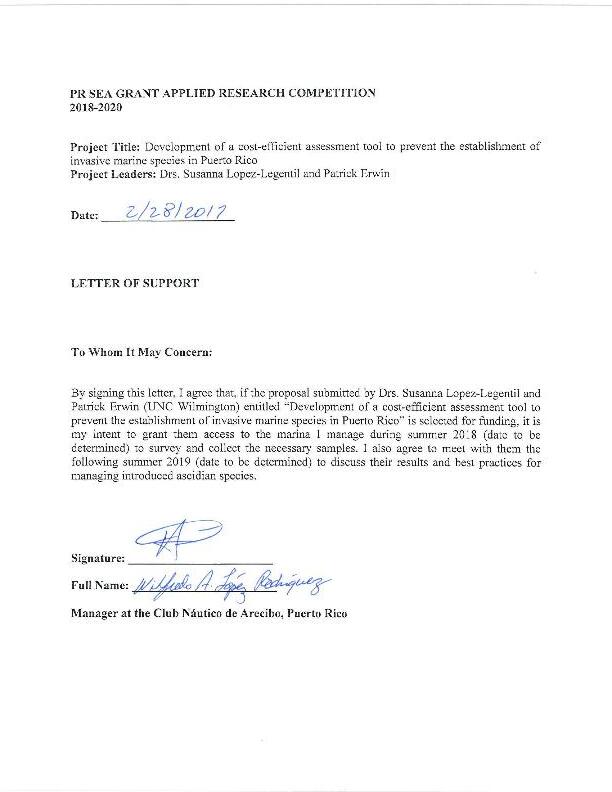
B. Harbor authorities (continued)
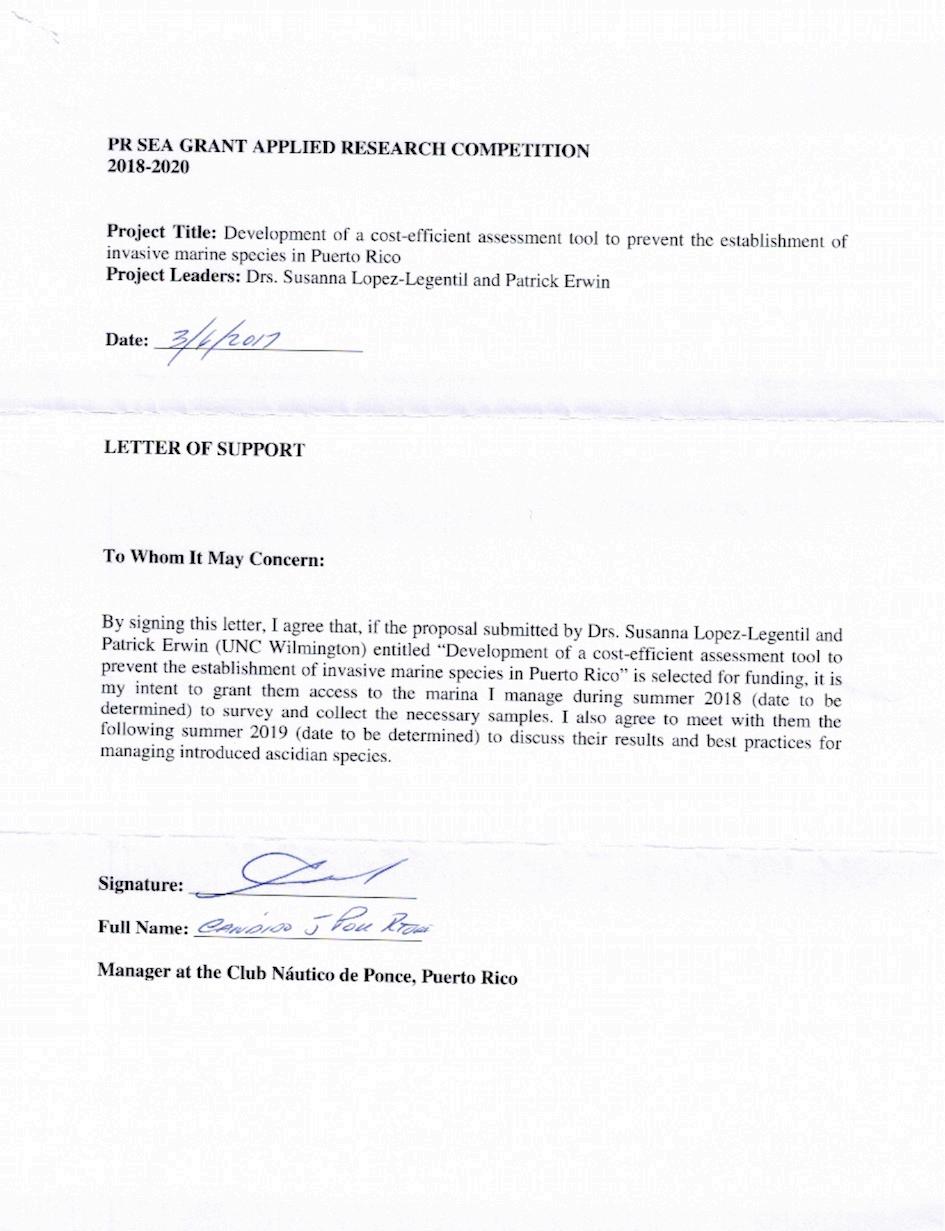
B. Harbor authorities (continued)
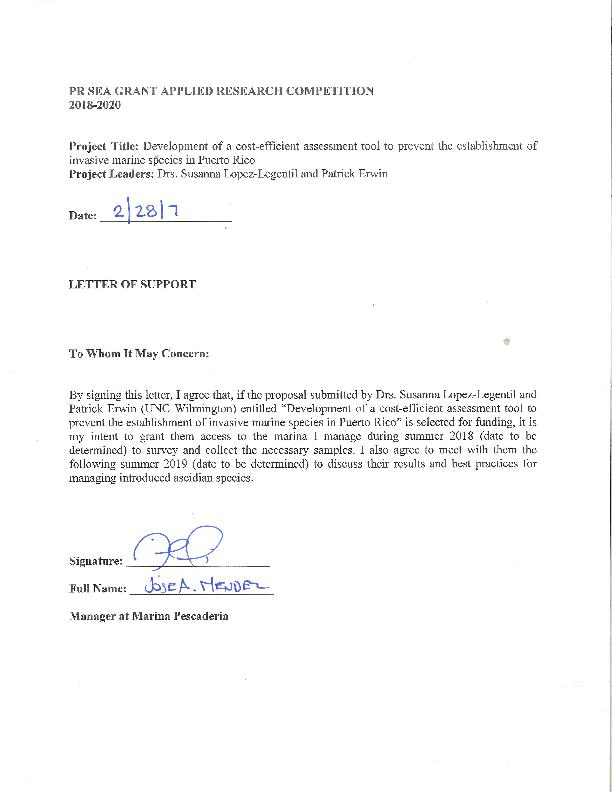
B. Harbor authorities (continued)

C. Public institutions
University of Puerto Rico, Mayaguez
PR SEA GRANT APPLIED RESEARCH COMPETITION 2018-2020
Project Title: Development of a cost-efficient assessment tool to prevent the establishment of invasive marine species in Puerto Rico
Project Leaders: Drs. Susanna Lopez-Legentil and Patrick Erwin
Date: February 22, 2017
To Whom It May Concern:
By signing this letter I agree that if the proposal submitted by Drs. Susanna Lopez-Legentil and Patrick Erwin (UNC Wilmington) entitled “Development of a cost-efficient assessment tool to prevent the establishment of invasive marine species in Puerto Rico” is selected for funding, it is my intent to host a talk about this topic at my Institution during summer 2019.
Ernesto Weil, Ph.D
Professor
Dept. Marine Sciences
UPRM
Signature:
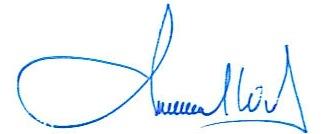
Institution: Department of Marine Sciences, University of Puerto Rico, Mayaguez
C. Public institutions (continued)
Center for Environmental Education, Conservation and Research at the Inter American University of Puerto Rico

D. Database curator
PR SEA GRANT APPLIED RESEARCH COMPETITION
2018-2020
Project Title: Development of a cost-efficient assessment tool to prevent the establishment of invasive marine species in Puerto Rico
Project Leaders: Drs. Susanna Lopez-Legentil and Patrick Erwin
Date: 07 March 2017
To Whom It May Concern:
By signing this letter I agree that if the proposal submitted by Drs. Susanna Lopez-Legentil and Patrick Erwin (UNC Wilmington) entitled “Development of a cost-efficient assessment tool to prevent the establishment of invasive marine species in Puerto Rico” is selected for funding by Puerto Rico Sea Grant, I am willing to update the information published in the World Register of Introduced Marine Species database (WRIMS) and the Ascidiacea World Database (AWD) to reflect their results

Signature: ________________________
Full Name: Dr. Xavier Turon, Research Professor CEAB-CSIC
Institution: Editor for the World Register of Introduced Marine Species (WRIMS) and the Ascidiacea World Database (AWD)
COST-SHARING
March 9, 2017

THE UNIVERSITY OF NORTH CAROLINA AT WILMINGTON
Dr. Kurt Grove, Research Coordinator
Puerto Rico Sea Grant
University of Puerto Rico Mayagüez Campus Call Box 9000 Mayagüez, PR 00681‐9000
Dear Dr. Grove and members of the review committee,
It is my pleasure to offer this letter of commitment in support of the research proposal submitted to the Puerto Rico Sea Grant Applied Research Competition 2018‐2020 by Drs. Susanna Lopez‐Legentil and Patrick Erwin. This knowledgeable and productive research team is proposing to describe ascidian species inhabiting Puerto Rican harbors and marinas, using both morphological and genetic approaches, and identify their introduction status and invasive risk level. As you know, invasive species can have significant negative impacts on native species, fisheries, and coastal infrastructure. Early detection of invasive species is critical to preventing establishment and aiding elimination. As such, this proposal is a good match for the goals of this RFP and a good match for the mission of Puerto Rico Sea Grant.
The Department of Biology and Marine Biology fully supports and endorses this project. To this end, the department will commit funds to support one MS student during the academic year for two years, provide domestic travel assistance to project leaders Lopez‐Legentil and Erwin, and support publication and documentation costs. Such funds will be allocated on an annual basis depending on availability and project needs.
Thank you for your time and consideration of this very worthy proposal. Please do not hesitate to contact me for any further information.
Best regards,

Christopher Finelli Professor and Chair Department of Biology and Marine Biology
SUGGESTED REVIEWERS
Specific research areas:
• Ascidian taxonomy
• Introduced/Invasive ascidian species
Potential reviewers:
1. Dr. Marie Nydam, Center College KY (USA), marie.nydam@centre.edu
2. Dr. Marc Rius, University of Southampton (UK), M.Rius@soton.ac.uk
3. Dr. Rosana da Rocha, Universidade Federal do Paraná Curitiba (Brazil), rmrocha@ufpr.br
4. Dr. Lauren Stefaniak, Georgia Southern University, lstefaniak@georgiasouthern.edu
5. Dr. Euichi Hirose, University of the Ryukyus (Japan), euichi@sci.u-ryukyu.ac.jp
